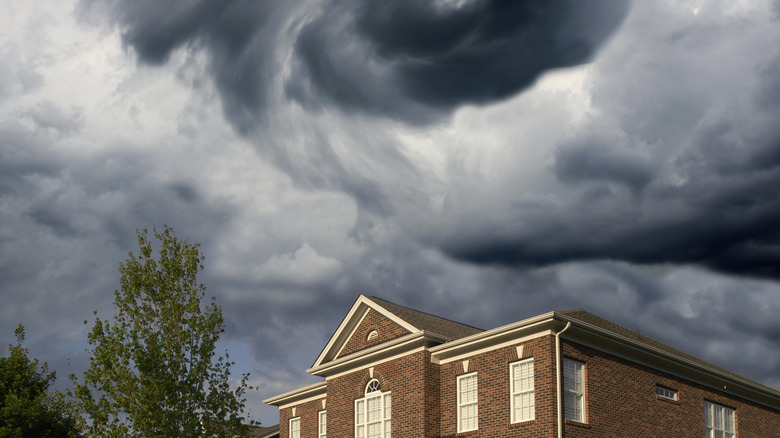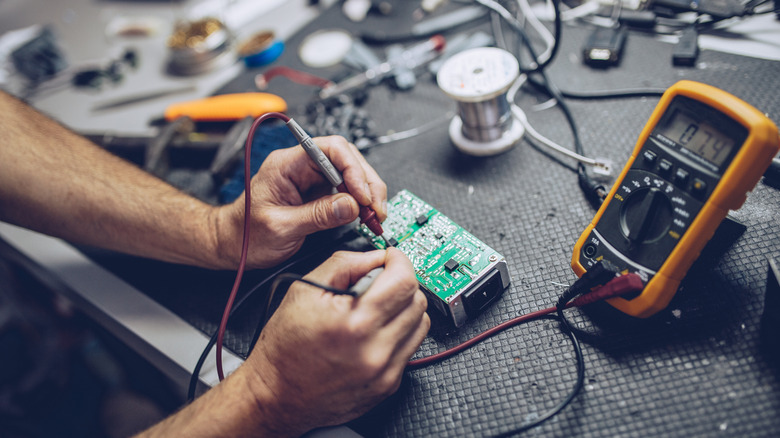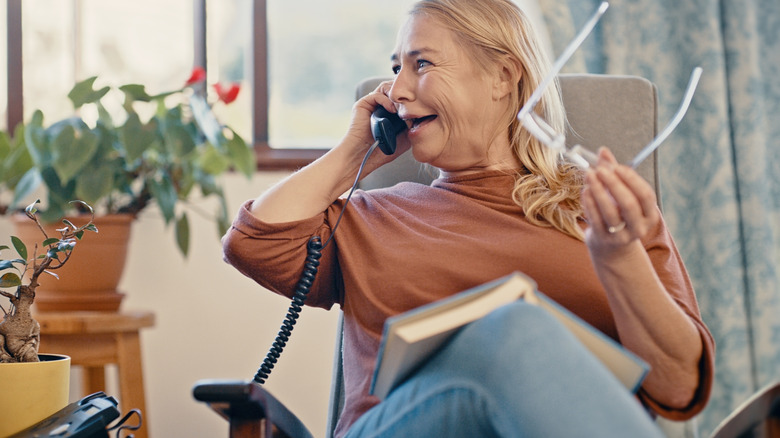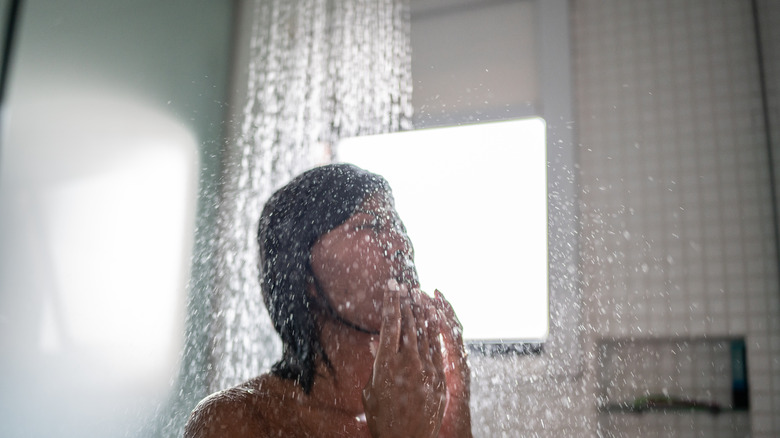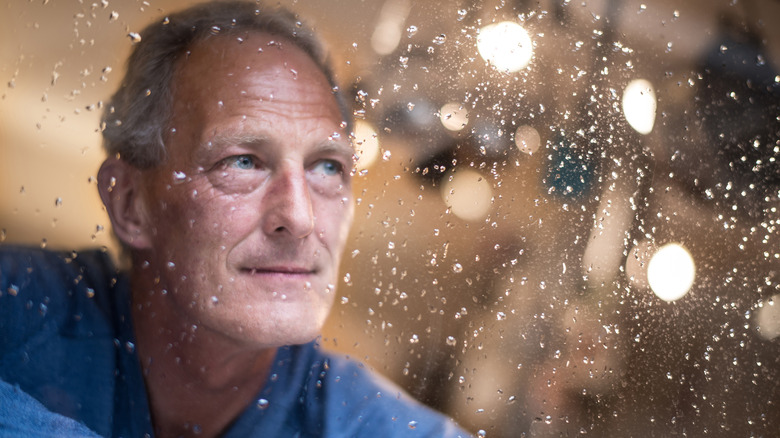Common Household Activities To Avoid At All Costs During A Thunderstorm
Thunderstorms, while a common natural phenomenon, carry a mix of beauty and danger. As they approach, the air fills with electricity, creating a sense of anticipation and, sometimes, anxiety. This electricity is caused by lightning, which manifests as an immense electrical discharge between various elements, including the air, the ground, and the clouds. At first, the air acts as a barrier, maintaining a separation between the positive and negative charges inside a cloud and also between the cloud and the ground. However, when these charged opposites accumulate to a breaking point, the air's insulating properties fail, leading to the striking spectacle we recognize as lightning. Ensuring safety during such storms is crucial, especially in the comfort of your own home where daily routines are expected to be safe. However, under the thrall of a thunderstorm, even mundane activities like chatting on a landline phone, showering, or simply walking across your carpeted living room can suddenly pose unexpected risks.
It's crucial to understand that the behaviors you consider safe under normal circumstances can transform into potential hazards during a thunderstorm. The National Weather Service (NWS) identifies three principal methods by which lightning can penetrate homes: striking the structure directly, moving along external conduits such as wires or pipes, or journeying through the earth to the foundation. You can minimize the risk of property damage from a storm – or risk of injury to the home's residents — by avoiding the following activities.
Using or repairing electrical systems
Lightning has a unique way of traveling, seeking the path of least resistance to the ground. Often, this path leads directly through a building's electrical wiring, plumbing, and any metal wires or bars in concrete walls or flooring. When lightning strikes a structure or even nearby, it can cause a sudden surge of electricity through these paths. This surge is far beyond what home appliances and systems are designed to handle, leading to potential damage or, worse, fires. Given this risk, it's paramount to take proactive measures to protect your home's electrical gadgets and systems. The first line of defense is to unplug devices before the storm hits. Avoid using devices that plug into the wall, like desktop computers or wired gaming consoles, as lightning can travel through electrical systems. Fixing or tinkering with electrical outlets or the home's wiring during a storm increases the risk of electrocution.
For those appliances or systems that cannot be easily unplugged, using a surge protector offers a layer of protection. These devices are designed to absorb excess electricity and prevent it from reaching connected appliances. Moreover, understanding that metal pipes and wires are natural conduits for lightning highlights the importance of considering the layout of a building's electrical and plumbing systems. In new constructions or renovations, positioning these elements in such a way that they're less likely to act as direct paths for lightning can reduce the risk of surges.
Talking on a corded phone
Diving into the realm of communication during a thunderstorm brings us to a very common yet overlooked risk: using a corded phone. Just as engaging with any electrical system presents a hazard during storms due to lightning's affinity for electrical paths, so too does the act of talking on a corded phone. The underlying issue here mirrors that of handling electrical systems — these phones are directly connected to the external wiring of your house, providing a seamless path for lightning to travel. Lightning, in its quest for the ground, utilizes wires and metal conduits as highways. When it strikes, it can follow the telephone wires right into your home and, consequently, to the handset you're holding. This can result in severe electrical shocks, or worse, making the use of corded phones during a thunderstorm a risky endeavor.
Given this potential danger, the safest course of action is to switch to alternatives like cordless phones or cell phones during a storm. Mobile phones, operating as low-power devices, don't share the same vulnerabilities as their corded counterparts. They aren't connected to the external wiring networks that lightning exploits, thus significantly reducing the risk of electrical shock. Furthermore, mobile phones' design and operational characteristics don't attract lightning strikes, making them a safer communication tool when the weather turns foul.
Running a shower
Water conducts electricity, so taking a shower or bath can be dangerous if lightning strikes your plumbing system. You might not immediately connect the dots between running a shower during a thunderstorm and potential danger, but the connection is there, and it's a risk worth taking seriously. The main concern with using a shower — or any plumbing, for that matter– during a thunderstorm stems from the way lightning interacts with a building's plumbing system. Many homes are equipped with metal pipes, a material known for its excellent electrical conductivity. This means if lightning strikes your home, or even nearby, it can travel through the plumbing system with ease. Engaging in activities that put you in direct contact with water, such as showering, can inadvertently place you on a path that lightning might be traveling. This scenario significantly elevates the risk of electrocution, a sobering thought that underscores why it's wise to avoid showering during storms.
It's true that homes with plastic piping are at a lesser risk compared to those with metal plumbing. However, water, in its essence, remains a conductor due to the minerals present. Its presence means that the risk, albeit lower, persists due to water's ability to carry an electrical charge, potentially finding other paths into your home that lightning could exploit. The mere presence of water itself, along with the potential for lightning to find other conductive paths inside, means that the risk, though reduced, is not entirely eliminated. Therefore, the safest approach during a thunderstorm is to steer clear of any activities that involve using water from the plumbing system.
Washing the dishes
Stepping into the kitchen to wash dishes during a thunderstorm might seem like a productive use of time, but it's an activity that comes with unexpected risks. It's closely linked to the same concerns we have about taking showers when lightning is striking overhead. As mentioned earlier, when lightning strikes, its search for a grounding path can lead it through your home's plumbing system. This system, often made of metal, can conduct electricity directly to any point of contact with water. So, if you're washing dishes, should lightning strike and follow the plumbing toward your home, that electrical current can travel through the water, out the faucet, and into you. Speaking of faucets, even just touching this fixture can cause electrocution. This risk isn't limited to just faucets, either. It includes any metal plumbing fixture, such as shower knobs, toilet handles, or even the toilet itself. Yes, you read that right — even sitting on the toilet during a storm can pose a risk if lightning decides to visit your plumbing.
This might sound like a scene from a quirky horror movie, but the science behind it is solid, and the risk is real. The human body is just as good a conductor of electricity, thanks to the minerals it contains. This means if there's an easier path through you, electricity will take it. This makes even seemingly benign activities like washing dishes or hands during a storm a gamble with safety. So, what to do to prepare for a severe storm? The answer is simple: Postpone any of these activities until after the storm has passed.
Doing your laundry
Still on the topic of electricity and its interaction with thunderstorms, tackling laundry during such times carries its own set of risks, perhaps even more so than washing dishes. Why? Because your trusty washing machine, that cornerstone of household cleanliness, sits at a crossroads of vulnerability, hooked up to both your home's electrical and plumbing networks. As mentioned earlier, when lightning strikes, it doesn't necessarily need to hit your home directly to cause trouble. An indirect strike to nearby power lines, plumbing fixtures, structures, or even a tree can send a surge of high voltage scrambling through the home. This surge can easily reach your washing machine, risking significant damage to the appliance and possibly leading to dangerous situations if you're in contact with the machine or water at the time.
Consider the fact that modern home appliances often come equipped with sophisticated electronics and smart features. These advancements, while making laundry day a breeze under normal conditions, may also increase the potential for costly repairs or replacements after a storm-induced surge. The best advice? Postpone your laundry tasks until the storm has passed. It's a strategic pause that not only shields you from electrical hazards but also protects your washing machine from an untimely demise.
Standing near windows
Standing near windows during a storm might seem like a harmless way to witness nature's fury up close, but it's actually fraught with hidden dangers that are too significant to ignore. The risk comes from a combination of factors that can turn a moment of awe into a hazardous situation. Let's unpack why this seemingly innocent act is anything but safe. First off, windows are vulnerable points in any home during a storm. High winds can hurl debris — like branches, stones, or even items left unsecured in your yard — into the air with enough force to shatter glass. Being close to a window when this happens puts you at risk of being injured by flying glass shards, a danger that's as real as the storm itself. Severe storms can cause rapid pressure changes that have the potential to shatter windows, again posing a risk to anyone nearby.
Moreover, lightning is another concern. While the odds of lightning striking a window directly are slim, if the glass shatters, the risk of a strike becomes higher. Furthermore, if your window has metal frames, remember that the electrical charge from a nearby strike can travel through metal window frames, posing a risk of electrical shock to anyone in contact with the frame. So, what should you do? The advice is simple: Find a safer spot in your home, away from glass and potential entry points for the storm's wrath. It might be tempting to watch the storm's power unfold, but observing from a distance, away from windows, ensures that you can do so safely. Remember, the goal is to respect the storm's power without putting yourself in harm's way.
Opening the doors
Jumping right into why keeping doors closed during a storm is crucial, it's worth noting that this advice dovetails with the caution against standing near windows. The rationale behind both recommendations is rooted in safety and the integrity of your home's structure. At the same time, there's a common myth that opening doors during severe storms allows wind to pass harmlessly through the house, which supposedly eases pressure on the structure of your home. But let's be clear: Following that advice is like inviting trouble over for dinner. To put this myth to rest, the Insurance Institute for Business & Home Safety ran an eye-opening experiment. They compared two houses: one with the front door wide open and the other with everything sealed tight under the force of hurricane-like winds. The results? The house with the open door quickly lost its roof to the storm, dramatically showing how winds, when given a way in, can push upward and literally lift the roof off a house.
Keeping your doors and windows shut tight does more than just keep the rain and debris out. It also helps to manage and reduce the wind's force inside your home, significantly lowering the chances of your roof deciding to part ways with the rest of the structure. So, despite what you might hear, opening your doors to a storm won't do your home any favors. In fact, it's quite the opposite.
Using a fireplace
Using a fireplace during a storm might feel like the perfect way to relax while the storm passes. However, this picture-perfect moment comes with hidden dangers. The serene crackle of the fire could quickly turn into a hazardous situation due to lightning strikes. These natural electrical discharges are notorious for seeking out high points to hit, and chimneys stand tall as prime targets. The impact of a lightning strike on a chimney can be catastrophic, causing attic and roof fires. The journey of the strike doesn't end at the point of contact. It can enter your chimney, endangering the whole building by wreaking havoc on its way down. If you're nestled by the fireplace when this happens, the risk of electrocution becomes a stark reality, turning a cozy setting into a dangerous trap.
Beyond the immediate risks that lightning poses to chimneys during a storm, chimneys — especially those made of brick or stone — can suffer hidden damages after a lightning strike. The intense heat and electrical charge from a lightning bolt can cause cracks and structural weaknesses not visible to the naked eye. Over time, these vulnerabilities can lead to water leakage in your home, further eroding the chimney's structure and potentially leading to costly repairs. In light of these risks, it's wise to consider installing a lightning protection system. This setup typically involves a network of conductors and grounding electrodes designed to attract the lightning strike and safely direct its energy into the ground, bypassing your home's structure.
Walking barefoot on floors
Treading barefoot on floors, particularly those made of concrete, during a storm significantly ups the stakes of encountering lightning's unpredictable nature. It's not just about the obvious danger of a lightning strike but also the intricate, less visible hazards that come into play. The reason behind this caution is twofold. Both the soil and concrete (especially when damp) serve as channels for lightning's electrical charge, creating a precarious situation even if you're not directly hit. Concrete, often reinforced with metal to increase its strength, inadvertently becomes an efficient conductor for lightning, more so than air. This can lead to scenarios where lightning, seeking the path of least resistance to the ground, opts for concrete as its conduit. The energy from a lightning strike can shatter concrete, posing an immediate danger to anyone on or near it.
Moreover, in areas equipped with systems designed to safely direct lightning into the earth, an unexpected phenomenon occurs. The presence of these systems can generate an opposing charge within the concrete's metal reinforcements, potentially causing a secondary discharge. This sideflash can have an explosive impact on the concrete, causing it to burst apart with little to no warning. Given these risks, it's wise to steer clear of concrete surfaces during storms. This advice extends beyond mere caution — it's about ensuring your safety in the face of the complex and hazardous ways lightning interacts with our surroundings.
